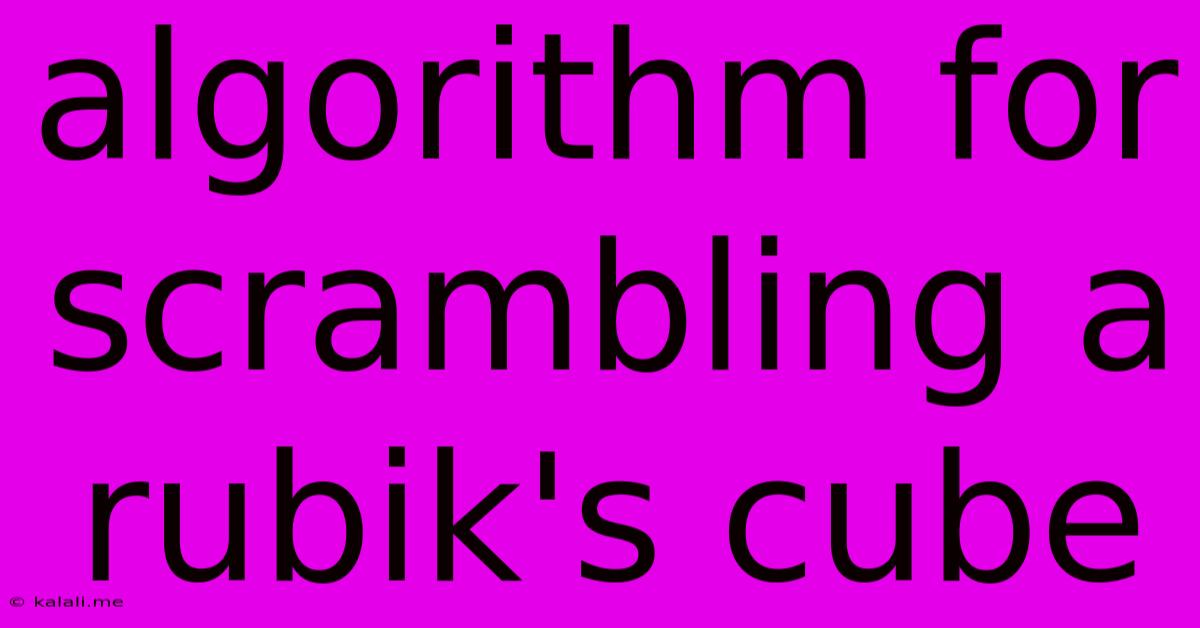Algorithm For Scrambling A Rubik's Cube
Kalali
Jun 08, 2025 · 3 min read

Table of Contents
Algorithms for Scrambling a Rubik's Cube: Achieving Randomness and Solvability
This article delves into the fascinating world of Rubik's Cube scrambling algorithms. We'll explore why simple random moves aren't sufficient for a truly random scramble, and we'll examine effective algorithms used to generate scrambles suitable for competitions and practice. Understanding these algorithms is crucial for anyone serious about speedcubing or simply appreciating the mathematical elegance of the cube.
Why Random Moves Aren't Enough
While it might seem intuitive to simply make a series of random moves, this approach has serious drawbacks. Purely random sequences are likely to result in scrambles that are either too easy or, conversely, nearly impossible to solve. This is due to the inherent structure and symmetries within the Rubik's Cube's state space. A truly random scramble needs to explore this state space effectively, ensuring a challenging but solvable puzzle.
The Role of Algorithm Design
Effective scrambling algorithms aim to achieve several key goals:
- Sufficient Randomness: The scramble should be unpredictable and complex enough to prevent trivial solutions.
- Solvability: The algorithm must guarantee a scramble that can be solved, avoiding states that are impossible to reach through legal moves.
- Uniform Distribution: The algorithm should distribute the cube's possible states as evenly as possible, avoiding biases towards certain configurations.
- Repeatable Scrambles: For competitions, it's essential to be able to generate the same scramble repeatedly using a defined sequence.
Common Scrambling Algorithms and their Properties
Several algorithms are used to create scrambles for competitions. These algorithms often involve sequences of moves, carefully chosen to ensure sufficient randomness and solvability. They often prioritize a balance between the number of moves and the resulting complexity.
-
WCA Scramble Generation: The World Cube Association (WCA) uses a computer program that generates scrambles meeting specific criteria. These scrambles are designed to minimize the likelihood of easily solvable states. They are widely considered the gold standard for competition scrambles, and the WCA publishes the algorithms and parameters used. The algorithms ensure a sufficient number of moves and prevent any obvious patterns or easily solvable subsets.
-
Other Algorithmic Approaches: While the WCA algorithm is highly effective, other algorithms exist. Some might prioritize shorter scrambles while still maintaining an adequate level of complexity. These algorithms often leverage principles from graph theory and group theory to navigate the vast state space of the cube.
Understanding the Mathematics Behind Scramble Generation
The mathematics underlying effective scramble generation is complex and involves concepts from group theory, specifically the group of Rubik's Cube moves. The goal is to create a sequence of moves that effectively mixes the cube's pieces, exploring a large portion of the cube's possible state space while ensuring solvability. The algorithms cleverly manipulate the cube's subgroups to avoid repetitive patterns and ensure a well-distributed, random-looking state.
Practical Considerations for Scrambling
Regardless of the algorithm used, several practical considerations are crucial:
- Use a reputable scramble generator: For competitions, always use a WCA-compliant scramble generator to ensure fairness and consistency.
- Avoid manual scrambles: Relying on random moves manually is unreliable and will likely lead to inconsistencies in scramble difficulty.
- Record your scrambles: Keep a record of your scrambles for practice or competition.
Conclusion
Generating effective Rubik's Cube scrambles is more than just making random moves. It involves understanding the underlying mathematics and using algorithms designed to achieve a balance between randomness, solvability, and a uniform distribution of states. Using sophisticated algorithms guarantees fair and challenging puzzles for both casual solvers and competitive speedcubers. The intricacies of scramble generation are a testament to the remarkable complexity and mathematical depth hidden within this seemingly simple toy.
Latest Posts
Latest Posts
-
Free Backgrounds To Create Photshop Tags
Jun 08, 2025
-
Go Fast Alone Go Far Together
Jun 08, 2025
-
Thank You So So Very Much
Jun 08, 2025
-
Shower Handle Sticks Out Too Far
Jun 08, 2025
-
How To Find Percentage From Mean And Standard Deviation
Jun 08, 2025
Related Post
Thank you for visiting our website which covers about Algorithm For Scrambling A Rubik's Cube . We hope the information provided has been useful to you. Feel free to contact us if you have any questions or need further assistance. See you next time and don't miss to bookmark.